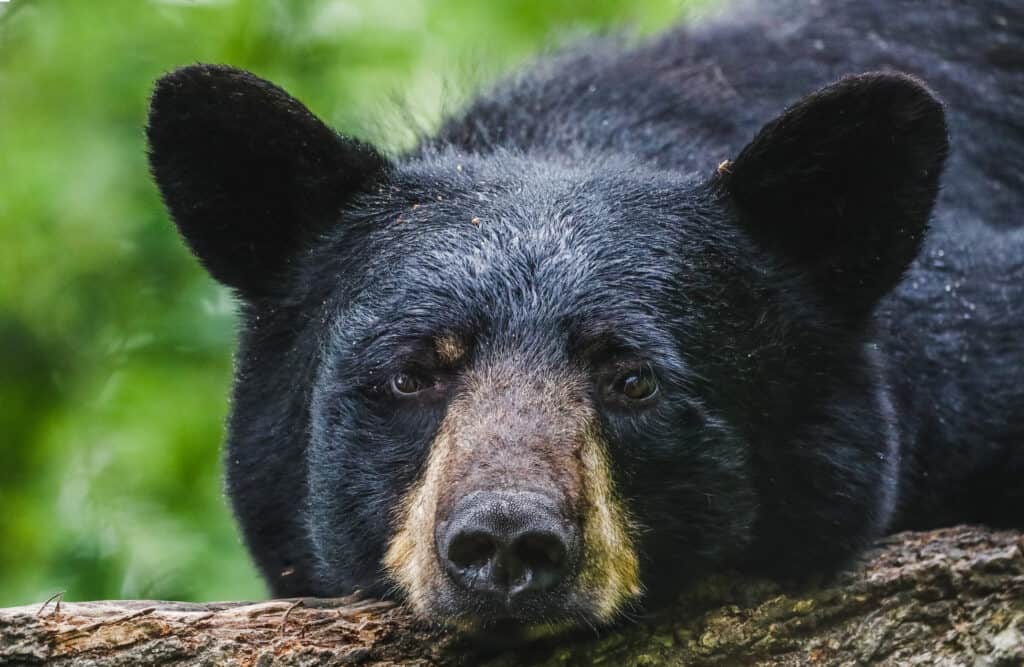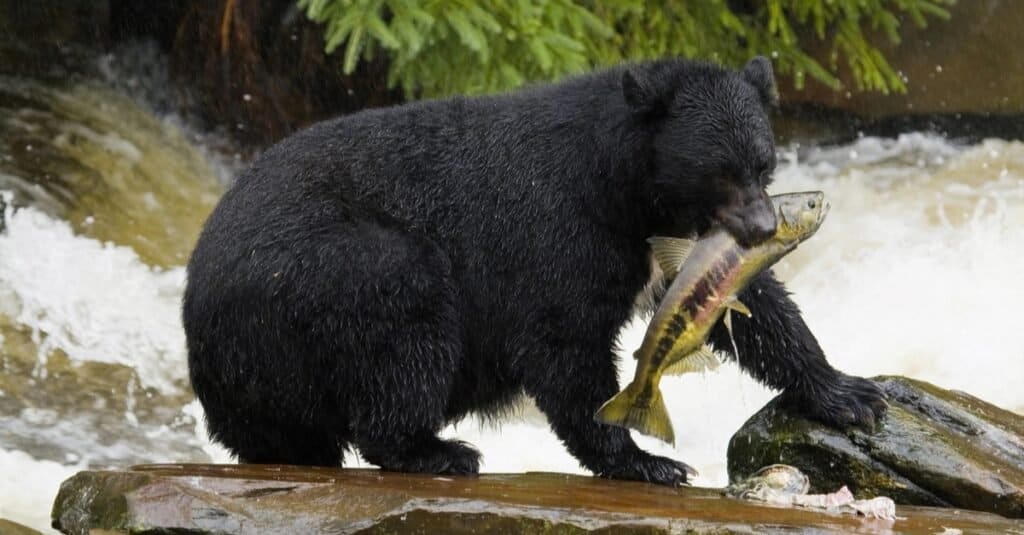Black bears are one of the most recognized bears in North America. The black bear possesses many different skills, allowing these animals to thrive in their various habitats scattered across the continent. For instance, they are excellent climbers!
If you want to learn more about the American black bear, keep reading!
Species Profile: American Black Bears
The American black bear is also known as the black bear or, less commonly, the baribal. It is a medium-sized species of bear native to North America, for which it gains its name. It is a species of least concern, and it is one of only two species of bears that do not face extinction.

Because of their diet and behavior, you won’t often find the American black bear in open areas and plains.
©iStock.com/Mandy Fuller Photography
Where Do Black Bears Live?
American black bears are endemic to North America. This means that this is the only continent where you will find them naturally occurring. They are most common in the northernmost regions of the continent, although they can be found scattered throughout the south as well. Their most common habitats are located in Canada and the Northern United States. Populations are also scattered throughout the Rocky Mountains of the west and throughout northern and central Mexico.
Black bears prefer forest and alpine environments. They can thrive in two different types of forests: coniferous and deciduous. Because of their diet and behavior, you won’t often find the American black bear in open areas and plains. This includes the Great Plains of the Midwestern region of the United States. However, in these otherwise uninhabited areas, you may find individuals or populations along rivers, where vegetation is denser.
How Many Kinds of Black Bears Are There?
Traditionally, there are 16 different subspecies of the American black bear. There is also a species of bear known as Asiatic black bears, which can be distinguished by the white markings on their chest. American black bears and Asiatic black bears are related (in fact, they’re considered sister taxa!), but they are not the same species.
The different subspecies of black bear located in the United States are the following:
- Olympic black bear (Ursus americanus altifrontalis)
- New Mexico black bear (Ursus americanus amblyceps)
- Eastern black bear (Ursus americanus americanus)
- California black bear ( Ursus americanus californiensis)
- Haida Gwaii black bear (Ursus americanus carlottae)
- Cinnamon bear (Ursus americanus cinnamomum)
- Glacier bear (Ursus americanus emmonsii)
- East Mexican black bear (Ursus americanus eremicus)
- Florida black bear (Ursus americanus floridanus)
- Newfoundland black bear (Ursus americanus hamiltoni)
- Kermode bear (Ursus americanus kermodei)
- Louisiana black bear (Ursus americanus luteolus)
- West Mexican black bear (Ursus americanus machetes)
- Kenai black bear (Ursus americanus perniger)
- Dall Island black bear (Ursus americanus pugnax)
- Vancouver Island black bear (Ursus americanus vancouveri).
What Do Black Bears Eat?
Black bears are omnivores. They are primarily crepuscular, meaning they forage and eat at twilight, but black bears have been known to eat at any time. Although other bears have a diet that is mainly comprised of animal matter, around 85 percent of the American black bear’s diet is made up of vegetation and plant matter. Young shoots and bulbs from trees, grass, and shrubs are a significant part of the black bear’s diet, especially following hibernation. During the rest of the year, berries and fruits are important. They also eat carrion and fish.
When given the opportunity, the American black bear is also known to eat less common and less healthy food as it is available. This is most commonly seen around campsites and similar locations where black bears may eat human trash and exposed food. They may also eat honey from apiaries when available.

Young shoots and bulbs from trees, grass, and shrubs are a significant part of the black bear’s diet. They also eat carrion and fish.
©emperorcosar/Shutterstock.com
Are Black Bears Able to Climb Trees?
Yes, black bears can climb trees!
Black bears have strong, curved claws that allow them to climb trees quickly and gracefully. However, while they may climb up like other species of tree-climbing mammals, they don’t come down the same way. If you were to see a squirrel descending from a tree outside, you’d notice it would do so headfirst. However, like most mammals, the black bear shimmies down the tree, rear-end first.
The American black bear will climb a tree for various reasons. Young black bears will do so out of curiosity, often exploring the tops of high trees. Climbing trees can also offer protection to black bears, as well as the ability to forage for food or berries that may not be available on the ground.
3 Black Bear Facts
Aside from being an expert climber, the American black bear possesses many other interesting facts. Below, you’ll find three interesting black bear facts about this amazing species.
1. Black Bears are Good Swimmers
Those claws aren’t just good for climbing! Believe it or not, black bears are actually expert swimmers. One of the main animals in their diet is fish, and black bears are more than ready to dive into the water at a moment’s notice in pursuit of food. Young black bears, known as cubs, can also quickly take to the water, learning to swim relatively easily.
There is one story of a black bear swimming across the Gulf of Mexico! While this may be a myth, it is true that black bears have been known to swim to campsites to scavenge through the trash.

Black bears can quickly take to the water, learning to swim relatively easily.
©jo Crebbin/Shutterstock.com
2. They Can Reach Speeds of Over 30 Miles per Hour
Typically, these bears tend to be a bit sluggish. They prefer to walk at a slow pace, taking their time to observe their surroundings and sniff around for food. However, the American black bear excels when it comes time to run, just like with swimming and climbing.
When running, black bears can easily reach speeds over 30 miles per hour. This means that they could easily run alongside a car! However, while they do have the ability to run fast, black bears lack the capacity to maintain these speeds. They quickly tire out. This is especially true for bears in late fall, winter, or early spring. During this time, they’re still sporting their heavy, thick winter fur coats and hibernation weight.
3. Black Bears are Not Known to be as Aggressive as Other Species of Bear
Black bears very rarely attack humans. While grizzly bears are known to attack and even kill humans, especially when it comes to defending their cubs, the same isn’t true for the American black bear.
Black bears don’t see us as prey. As a result, they won’t go out of their way to hunt people. When black bear attacks do happen, it usually begins because of dogs. Dogs tend to scare black bears and their cubs, causing the animals to flee. Usually, this escape involves climbing a tree. Because the black bear feels threatened at this time, they’re more likely to act out of self-defense, which can be dangerous for humans and pets alike. But ultimately, if they are not spooked, they remain non-aggressive.
However, despite their cute appearance and gentle nature, they are still wild animals. This means that no matter how gentle or docile they seem, black bears can still act unpredictably and aggressively. Because of this, it is best to execute caution if you cross paths with a black bear.
The photo featured at the top of this post is © Debbie Steinhausser/Shutterstock.com
Thank you for reading! Have some feedback for us? Contact the AZ Animals editorial team.






